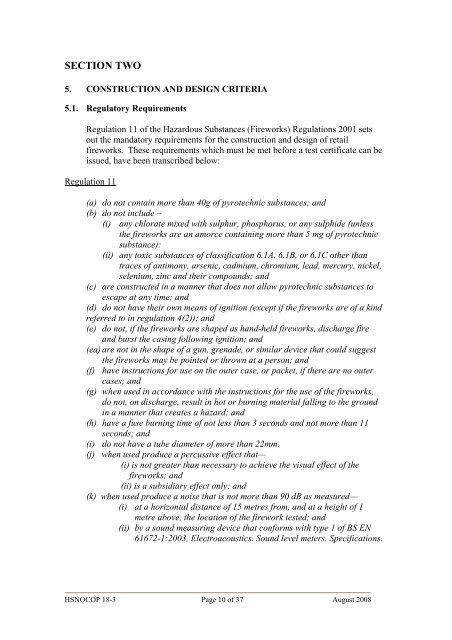Code of practice for retail fireworks - Environmental Protection ...
Code of practice for retail fireworks - Environmental Protection ...
Code of practice for retail fireworks - Environmental Protection ...
You also want an ePaper? Increase the reach of your titles
YUMPU automatically turns print PDFs into web optimized ePapers that Google loves.
SECTION TWO<br />
5. CONSTRUCTION AND DESIGN CRITERIA<br />
5.1. Regulatory Requirements<br />
Regulation 11 <strong>of</strong> the Hazardous Substances (Fireworks) Regulations 2001 sets<br />
out the mandatory requirements <strong>for</strong> the construction and design <strong>of</strong> <strong>retail</strong><br />
<strong>fireworks</strong>. These requirements which must be met be<strong>for</strong>e a test certificate can be<br />
issued, have been transcribed below:<br />
Regulation 11<br />
(a) do not contain more than 40g <strong>of</strong> pyrotechnic substances; and<br />
(b) do not include –<br />
(i) any chlorate mixed with sulphur, phosphorus, or any sulphide (unless<br />
the <strong>fireworks</strong> are an amorce containing more than 5 mg <strong>of</strong> pyrotechnic<br />
substance):<br />
(ii) any toxic substances <strong>of</strong> classification 6.1A, 6.1B, or 6.1C other than<br />
traces <strong>of</strong> antimony, arsenic, cadmium, chromium, lead, mercury, nickel,<br />
selenium, zinc and their compounds; and<br />
(c) are constructed in a manner that does not allow pyrotechnic substances to<br />
escape at any time; and<br />
(d) do not have their own means <strong>of</strong> ignition (except if the <strong>fireworks</strong> are <strong>of</strong> a kind<br />
referred to in regulation 4(2)); and<br />
(e) do not, if the <strong>fireworks</strong> are shaped as hand-held <strong>fireworks</strong>, discharge fire<br />
and burst the casing following ignition; and<br />
(ea) are not in the shape <strong>of</strong> a gun, grenade, or similar device that could suggest<br />
the <strong>fireworks</strong> may be pointed or thrown at a person; and<br />
(f) have instructions <strong>for</strong> use on the outer case, or packet, if there are no outer<br />
cases; and<br />
(g) when used in accordance with the instructions <strong>for</strong> the use <strong>of</strong> the <strong>fireworks</strong>,<br />
do not, on discharge, result in hot or burning material falling to the ground<br />
in a manner that creates a hazard; and<br />
(h) have a fuse burning time <strong>of</strong> not less than 3 seconds and not more than 11<br />
seconds; and<br />
(i) do not have a tube diameter <strong>of</strong> more than 22mm.<br />
(j) when used produce a percussive effect that—<br />
(i) is not greater than necessary to achieve the visual effect <strong>of</strong> the<br />
<strong>fireworks</strong>; and<br />
(ii) is a subsidiary effect only; and<br />
(k) when used produce a noise that is not more than 90 dB as measured—<br />
(i) at a horizontal distance <strong>of</strong> 15 metres from, and at a height <strong>of</strong> 1<br />
metre above, the location <strong>of</strong> the firework tested; and<br />
(ii) by a sound measuring device that con<strong>for</strong>ms with type 1 <strong>of</strong> BS EN<br />
61672-1:2003, Electroacoustics. Sound level meters. Specifications.<br />
HSNOCOP 18-3 Page 10 <strong>of</strong> 37 August 2008








![Application for test certificate [pdf, 131kb]](https://img.yumpu.com/50666502/1/184x260/application-for-test-certificate-pdf-131kb.jpg?quality=85)








